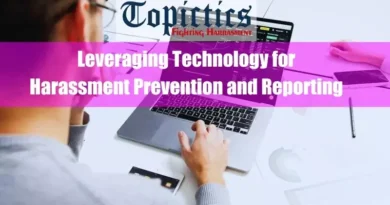Ongoing Initiatives: Building a Harassment-Free Workplace
Takeaways
| Key Points |
|---|
| A professional workplace is one where respect, dignity, and inclusivity are embedded in everyday interactions, ensuring a safe and supportive environment for all employees. |
| Such a culture prioritizes teamwork, open communication, and mutual trust, creating conditions for both individual and organizational success. |
| However, workplace harassment continues to present significant challenges, ranging from overt bullying to subtle microaggressions, negatively impacting morale, productivity, and employee well-being. |
| These issues also expose organizations to legal liabilities and reputational damage, underscoring the need for comprehensive strategies. |
| Increasingly, organizations are taking proactive steps by implementing robust policies, fostering cultural change, and developing preventative measures to establish workplaces that are truly free from harassment. |
Introduction
Workplace harassment harms workplaces worldwide, whether it’s outright bullying or more subtle actions. It lowers morale, reduces productivity, and affects the well-being of employees. It also leads to costly lawsuits and damages a company’s reputation.
However, things are changing! More attention is being given to harassment, and organizations are now taking proactive steps to create truly harassment-free environments.
Building a Preventative Foundation

A. Policy and Enforcement
A comprehensive and active anti-harassment policy is the bedrock of any organization committed to maintaining a safe workplace. This isn’t just about having a document—it’s about creating a living, breathing guide that protects employees and sets clear expectations. Here’s what your policy should include:
1. Defining Harassment in All Its Forms:
Harassment should be clearly defined, leaving no room for ambiguity. Your policy must address various forms, including:
- Discrimination: Unfair treatment based on race, gender, religion, sexual orientation, disability, or any other protected characteristic.
- Bullying: Actions such as intimidation, physical aggression, verbal abuse, or social exclusion that create a hostile environment.
- Sexual Harassment: Any unwelcome sexual advances, comments, or physical acts that violate someone’s dignity.
- Microaggressions: Small but harmful actions or comments perpetuating stereotypes, making certain groups uncomfortable in the workplace.
By defining these behaviors clearly, your policy sets a standard that unacceptable conduct won’t be tolerated.
2. Reporting Procedures and Channels:
A robust reporting system is essential to encourage employees to speak up about harassment. Your policy should offer multiple ways to report, tailored to different comfort levels:
- Direct Reporting to Managers or HR: Employees should easily be able to report issues directly within the organization’s hierarchy.
- Anonymous Online Reporting Systems: These systems provide a safe way for employees to report without revealing their identity.
- Third-Party Hotlines: Offering an external reporting channel can provide an additional layer of security and impartiality.
The goal is to create an environment where reporting is seen as a positive and necessary action, free from fear of retaliation.
3. Investigation and Resolution Processes:
Once a report is filed, your policy must outline a clear, fair, and transparent process for handling complaints. This includes:
- Prompt and Impartial Investigations: Every complaint should be taken seriously and investigated promptly, ensuring a fair outcome for all parties.
- Confidentiality: Protecting the privacy of those involved is crucial to maintaining trust.
- Clear Communication: The investigation’s progress should be communicated to both the complainant and the accused, ensuring transparency.
- Appropriate Consequences: The policy should detail the possible outcomes of an investigation, ranging from warnings to termination, depending on the severity of the incident.
By setting these guidelines, your policy ensures that all complaints are handled consistently and fairly, fostering a sense of justice and accountability.
4. Keeping Your Policy Current:
Your policy should not remain static. Regular reviews and updates are necessary to ensure it continues to address emerging forms of harassment and aligns with current best practices. This commitment to evolution signals that your organization takes harassment seriously and is always looking to improve its approach.
5. Effective Training and Communication:
A policy is only as good as the understanding and engagement of those it protects. Therefore, training and communication are critical:
- Interactive Training Programs: Go beyond traditional lectures with sessions that involve role-playing, scenario analysis, and discussions to help employees internalize the policy.
- Consistent Messaging: Regular reminders through meetings, newsletters, and internal communications ensure that the policy remains at the top of people’s minds.
- Open Communication Channels: Encourage ongoing dialogue where employees can ask questions, seek clarity, and discuss concerns without hesitation.
This approach ensures that employees are aware of the policy and equipped to act following it.
B. Culture Change and Bystander Intervention
Creating a harassment-free workplace requires more than just policies; it demands a cultural shift. This means fostering an environment where respect, inclusivity, and open communication are the norms, and everyone is empowered to act against harmful behavior.
1. Fostering Respect and Inclusivity:
- Celebrating Diversity: A workplace that actively embraces and celebrates differences in background, identity, and thought creates a more inclusive environment. Initiatives such as diversity events, inclusive hiring practices, and employee resource groups help build a culture of respect.
- Open Communication: Encourage a workplace where dialogue is open, feedback is welcomed, and employees feel safe to express their views. This transparency helps prevent harmful behaviors from taking root.
- Addressing Unconscious Bias and Microaggressions: Implement training that helps employees recognize their own biases and understand the impact of microaggressions. Encourage open discussions about these issues, offering a safe space for employees to share experiences and learn together.
2. Empowering Bystanders:
Bystanders play a crucial role in preventing harassment but need the right tools and confidence to act effectively.
- Bystander Intervention Training: Provide training that teaches employees to recognize harassment and respond appropriately. This can include direct intervention, reporting the incident, or seeking help from others.
- Building Confidence and Support: Address the fears that might prevent bystanders from acting, such as fear of retaliation or social repercussions. Creating a supportive environment where intervention is encouraged can help overcome these barriers.
- Celebrating Bystanders: Publicly recognizing those who intervene sends a strong message that your organization values and supports proactive efforts to maintain a safe workplace.
Empowering bystanders creates a network of individuals who actively contribute to a culture of safety and respect.
C. Building Supportive Systems
Even with strong preventative measures, some employees may still experience or witness harassment. Providing robust support systems is essential to help them feel heard and protected.
1. Confidential Reporting Mechanisms:
Employees need multiple, confidential avenues to report harassment, ensuring that they can choose the method that feels most comfortable:
- Multi-Channel Access: Offer various reporting options, such as online hotlines, in-person meetings with trusted personnel, and anonymous reporting systems.
- Trained and Impartial Investigators: Ensure that those handling complaints are trained and unbiased, capable of conducting thorough and fair investigations.
- Clear and Fair Resolution Processes: Clearly outline the process for resolving complaints, including timelines for investigation and options for appealing decisions.
These mechanisms reassure employees that their concerns will be handled with the seriousness and confidentiality they deserve.
2. Employee Assistance Programs (EAPs):
The emotional and psychological impact of harassment can be profound. Offering access to EAPs can provide essential support:
- Counseling and Support: Connect employees with professional counselors who can help them navigate the emotional aftermath of harassment.
- Mental Health Resources: Provide access to resources like stress management workshops and referrals to mental health professionals.
- Confidentiality and Privacy: Ensure that all interactions within the EAP are kept confidential, respecting the individual’s right to privacy.
By offering these resources, you provide a crucial support system for those affected by harassment.
3. Peer Support Networks and Mentorship Programs:
Peer support can be incredibly valuable for individuals who have experienced harassment. Consider implementing:
- Employee Resource Groups (ERGs): Encourage the formation of groups focused on harassment and discrimination, where employees can connect and support each other.
- Mentorship Programs: Pair those who have experienced harassment with mentors who can provide guidance and career advice.
- Safe Spaces for Open Dialogue: Organize workshops, discussion groups, or online forums where employees can share their experiences and find solidarity.
Building these support systems fosters a culture of empathy and understanding, empowering employees to address harassment confidently and constructively.
By implementing these strategies, you create a workplace where every employee feels safe, respected, and empowered to thrive.
Continuous Monitoring and Improvement

Building a harassment-free workplace isn’t a sprint but a marathon. Just like a thriving garden needs nurturing and vigilance, a safe and respectful work environment also requires continuous monitoring and improvement. This proactive approach ensures we don’t simply manage symptoms but constantly evolve and adapt to create a truly sustainable space for everyone to flourish. Let’s explore the key elements of this ongoing vigilance:
A. Regularly Collecting and Analyzing Data on Harassment Prevalence
Data is the language of progress, and when it comes to harassment, gathering accurate data is crucial. This involves:
- Employee Surveys: Regularly conducting anonymous surveys that provide insights into employee perceptions of the workplace environment, prevalence of harassment, and trust in reporting mechanisms.
- Formal Complaint Tracking: Monitoring the number and nature of formal complaints filed, analyzing trends, and identifying areas for improvement in policy or support systems.
- Informal Feedback Channels: Encouraging open communication through suggestion boxes, anonymous hotlines, or employee focus groups to capture broader experiences and concerns.
By actively listening to the whispers of data, we can understand the true scope of the challenge, measure the effectiveness of existing initiatives, and identify emerging trends that might require new interventions.
B. Conducting Climate Surveys to Assess Employee Perceptions
While data provides quantitative insights, employee perceptions paint a qualitative picture. Conducting regular climate surveys helps us understand how safe and respected employees feel in the workplace. This involves:
- Asking the Right Questions: Surveys should go beyond yes/no questions, delving into employees’ experiences with bystander intervention, trust in leadership, and effectiveness of support systems.
- Creating a Safe Space for Honest Feedback: Assure anonymity and confidentiality to encourage honest and candid responses that reflect the genuine pulse of the workplace.
- Taking Action on Feedback: Analyze the feedback carefully and translate it into actionable steps. This could involve revising policies, improving training programs, or strengthening support systems based on employee needs.
By regularly measuring the workplace climate, we can proactively address any underlying issues before they escalate, ensuring a healthy and respectful environment for everyone.
C. Evaluating the Effectiveness of Existing Initiatives
Every initiative is flawed, and ongoing evaluation is key to continuous improvement. This involves:
- Reviewing Policy and Training Effectiveness: Regularly assess the effectiveness of your anti-harassment policy and training programs. Are they keeping up with evolving forms of harassment and effectively equipping employees with the skills to address them?
- Measuring the Impact of Support Systems: Evaluate the utilization and effectiveness of EAPs, peer support networks, and mentorship programs. Do they provide adequate support and guidance for harassment victims?
- Adapting and Innovating: Based on the evaluation results, be willing to adapt existing initiatives and implement new ones as needed. Embrace innovation and stay abreast of best practices in harassment prevention and support.
By continuously evaluating and refining our efforts, we ensure they remain relevant, impactful, and responsive to the changing needs of the workplace and the individuals within it.
D. Learning from Others and Sharing Best Practices
No organization is an island. Collaboration and knowledge sharing are essential to accelerating progress. This involves:
- Benchmarking against other organizations: Compare your initiatives and success rates with other organizations in your industry or facing similar challenges. Learn from their successes and adapt best practices to your context.
- Participating in Conferences and Workshops: Attend industry events and workshops focused on harassment prevention and support. Engage with experts, gather new ideas, and network with other organizations facing similar challenges.
- Sharing Your Own Expertise: Don’t be a knowledge silo! Share your own successes and learnings with other organizations through case studies, presentations, or online forums.
Fostering a culture of open collaboration and knowledge sharing can collectively contribute to building a global movement towards harassment-free workplaces.
E. Remaining Proactive and Addressing New Forms of Harassment
The harassment landscape is constantly evolving, with new forms and technologies emerging. Therefore, remaining vigilant and proactive is crucial. This involves:
- Staying Informed about Emerging Trends: Keep abreast of research and trends on new forms of harassment, such as cyberbullying, online harassment, and microaggressions in virtual environments.
- Updating Policies and Training Programs: Ensure your policies and training programs adapt to address new forms of harassment. Train employees on how to identify and report these emerging threats.
- Fostering a Culture of Open Communication: Encourage ongoing dialogue and discussion about harassment in all its forms. Create a safe space for employees to raise concerns about emerging types of harmful behavior.
By consistently adapting and proactively addressing new forms of harassment, we ensure our efforts remain relevant and effective in safeguarding a truly safe and inclusive workplace for all.
Concluding Harassment-Free Workplace Ongoing Initiatives
As we reach the culmination of this journey, one thing becomes abundantly clear: building a harassment-free workplace isn’t a destination but an ongoing voyage of evolution. It demands constant vigilance, unwavering commitment, and a willingness to adapt and learn. Yet, as showcased in the inspiring case studies, the power of these ongoing initiatives paints a vibrant picture of the positive change within our grasp.
Let’s continue fostering the fertile ground for a future where harassment-free workplaces are an aspiration and a thriving reality.
FAQ
What is the “MySentry App” in workplace safety initiatives?
The MySentry App is an innovative workplace safety and reporting tool launched by Pakistan’s Federal Ombudsperson Secretariat for Protection Against Harassment (FOSPAH). This application enables employees to report incidents of harassment confidentially and access resources related to workplace safety, thereby promoting a secure and supportive work environment.
How does “Becky’s Button” enhance personal safety in public spaces?
Becky’s Button is a portable panic alarm introduced by FOSPAH to protect vulnerable women in public areas. When activated, it emits a loud alarm to deter potential harassers and attract immediate attention, serving as a deterrent against harassment and providing users with a sense of security.
What role does the “Creative Industries Independent Standards Authority (CIISA)” play in preventing workplace harassment?
The CIISA is an organization established to set behavior standards and address issues like bullying, harassment, and discrimination within the UK’s creative industries. CIISA aims to eliminate inappropriate behavior and power imbalances by providing guidelines and support mechanisms and fostering safer, more inclusive work environments.
How does “Psychological Safety” contribute to a harassment-free workplace?
Psychological safety refers to an environment where employees feel safe to express concerns, share ideas, and report inappropriate behavior without fear of retaliation. Promoting psychological safety encourages open communication and trust, which are crucial in preventing and addressing harassment.
What is “Integrated Support Systems” in the context of workplace harassment prevention?
Integrated support systems are comprehensive frameworks within organizations that address both harassment and mental health concerns. These systems provide multiple avenues for employees to seek help, including confidential counseling services, mental health first aiders, and peer support networks, ensuring holistic support for affected individuals.
How do “Proactive Wellness Initiatives” aid in harassment prevention?
Proactive wellness initiatives are programs designed to promote overall well-being and resilience among employees, thereby reducing the risk of harassment and its impact on mental health. These initiatives may include mindfulness sessions, stress management workshops, and access to fitness facilities, contributing to a positive and supportive workplace environment.
What is the significance of “Open Communication” in maintaining a harassment-free workplace?
Open communication involves creating an environment where employees can freely express concerns, grievances, and ideas without fear of retribution. Encouraging open dialogue builds trust between employees and management, which is essential for preventing and addressing harassment effectively.
How do “Diversity and Inclusion Initiatives” impact workplace harassment?
Diversity and inclusion initiatives focus on acknowledging and celebrating each employee’s unique backgrounds, perspectives, and experiences. Promoting respect for differences and creating an inclusive environment, these initiatives help break down stereotypes and biases, making harassment less likely to occur.
What is “Anonymous Reporting Systems” in harassment prevention strategies?
Anonymous reporting systems are mechanisms that allow employees to report incidents of harassment without revealing their identity. These systems encourage individuals to come forward with their concerns without fear of retaliation, facilitating a culture of transparency and accountability.
How does “Monitoring and Evaluation (M&E)” enhance the effectiveness of harassment policies?
Monitoring and Evaluation (M&E) involves implementing systems to track the impact of harassment prevention initiatives and identify areas for improvement. Regular assessments, such as employee surveys and feedback mechanisms, provide actionable insights into the effectiveness of policies and help organizations make necessary adjustments.
What is the “Feedback Loop” approach in preventing workplace harassment?
The feedback loop approach involves engaging employees in continuous improvement by creating regular opportunities for dialogue with leadership. This strategy fosters a culture of openness, where employees feel empowered to share their insights, leading to agile adjustments that can enhance productivity and drive organizational growth.
How do “Comprehensive Training Programs” contribute to a harassment-free workplace?
Comprehensive training programs educate employees about what constitutes harassment, how to prevent it, and the proper channels for reporting incidents. These programs raise awareness, promote respectful behavior, and ensure that employees understand their rights and responsibilities, thereby reducing the occurrence of harassment.
What is the role of “Leadership Commitment” in preventing workplace harassment?
Leadership commitment involves top management actively endorsing and participating in harassment prevention efforts. When leaders demonstrate a zero-tolerance stance on harassment and model respectful behavior, it sets a standard for the entire organization and reinforces the importance of a safe work environment.
How do “Clear Anti-Harassment Policies” function within organizations?
Clear anti-harassment policies outline unacceptable behaviors, reporting procedures, and consequences for violations. Having well-defined policies ensures that all employees are aware of the standards and protocols, which helps prevent harassment and facilitates appropriate responses when incidents occur.
What are “Supportive Counseling Services” in the context of workplace harassment?
Supportive counseling services provide employees with access to professional assistance to address the emotional and psychological impacts of harassment. These services offer confidential support, helping individuals cope with their experiences and promoting mental well-being within the workplace. By offering such support, organizations demonstrate their commitment to employee well-being, which can lead to improved morale, reduced absenteeism, and a more positive work environment.









